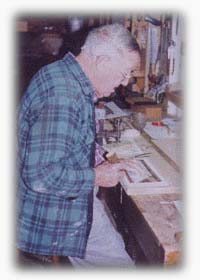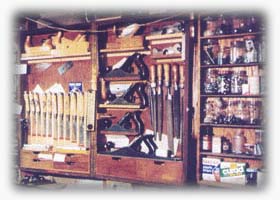|
 by Lisa Gabbert
by Lisa Gabbert
Listen:
Tony won't quit
My grandfather, Anton "Tony" Pramberger
long ago converted his one-car garage into a
workshop. This is his sacred space, and, like other sacred
spaces, the workshop has taken on a life of its own over the years. One of my
strongest childhood memories of him is the inordinate amount of time
he spent there. He would emerge from its dark recesses with
a lovely box or other wooden object to give away, but there was always
an aura of mystery surrounding his work and workspace.
 To the untrained eye, Tony's workshop looks like a chaotic jumble of
wood,woodblocks, tools, machines of various kinds, paper, buckets of glue,
nails, screws, fishooks, saws, razors, and brushes. A fine layer of
sawdust filters through the air. Upon closer examination, however,
the shop is perfectly organized and mirrors the meticulousness of his
mind and work. The walls are shelved, and lined with thousands of
glass jars filled to the brim with screws, nails, hooks of all kinds.
Each file, plane, chisel and saw has its particular spot and Tony has
at least two sets of everything-sometimes three. In the back corner
sits a cast-iron potbelly stove which serves as his heat source in
the winter, while a window air conditioning unit sits directly over
the workbench to keep him cool during the summer. Tony works
comfortably year round despite the extremities of New York weather.
To the untrained eye, Tony's workshop looks like a chaotic jumble of
wood,woodblocks, tools, machines of various kinds, paper, buckets of glue,
nails, screws, fishooks, saws, razors, and brushes. A fine layer of
sawdust filters through the air. Upon closer examination, however,
the shop is perfectly organized and mirrors the meticulousness of his
mind and work. The walls are shelved, and lined with thousands of
glass jars filled to the brim with screws, nails, hooks of all kinds.
Each file, plane, chisel and saw has its particular spot and Tony has
at least two sets of everything-sometimes three. In the back corner
sits a cast-iron potbelly stove which serves as his heat source in
the winter, while a window air conditioning unit sits directly over
the workbench to keep him cool during the summer. Tony works
comfortably year round despite the extremities of New York weather.
 Born in the former Austro-Hungarian Empire as an ethnic German in 1909,
Tony appreciated wood at an early age, apprenticed as a cabinet-maker
at the age of 13, and eventually attained the title of "master."
After he and his wife Elizabeth emigrated to New York in 1950, Tony
worked as the Steinway Company's chief pattern-maker until he
retired in 1976. Born in the former Austro-Hungarian Empire as an ethnic German in 1909,
Tony appreciated wood at an early age, apprenticed as a cabinet-maker
at the age of 13, and eventually attained the title of "master."
After he and his wife Elizabeth emigrated to New York in 1950, Tony
worked as the Steinway Company's chief pattern-maker until he
retired in 1976.
For Tony, one of the most frustrating things regarding his
craft is the constant confusion between cabinet-making and carpentry.
"I am not a carpenter," he insists, "I am a cabinet-maker." A
carpenter, he patiently explained to me for the tenth time, builds
houses, lays floors, and builds decks. A cabinet-maker, on the other
hand, makes furniture. And for Tony, trained in the old-school
European style, that means fashioning furniture with dovetail joints,
horsehide glue, and occasionally, tiny screws.
 Tony always has at least six or seven projects going at once.
Although he enjoyed his Steinway job, the position did not fully utilize his cabinet-making
skills and so instead he brought his craft home. Throughout the
years he has made small pieces of furniture, kitchen stools, a bar,
chess tables, pictures, hope chests, and many jewelry boxes which he
has given away to family members on special occasions. His crowning
talent is his knowledge of marquetry, the practice of inlaying bits of
wood, metal, ivory and other materials onto furniture, floors, and
objects to create pictures or geometric designs. Generally, a
basewood is covered with a thin veneer of rare and costly wood in
order to give the object are more luxuriant finish. Although Tony is
retired, his old Steinway buddies still bring him scraps of tropical
hardwoods left over after the instruments are made. He carefully
stores these treasures for future use and, if asked, can produce a
piece of cherry, mahogany, teak, palisander, curly walnut, or rosewood
at a moment's notice. Tony always has at least six or seven projects going at once.
Although he enjoyed his Steinway job, the position did not fully utilize his cabinet-making
skills and so instead he brought his craft home. Throughout the
years he has made small pieces of furniture, kitchen stools, a bar,
chess tables, pictures, hope chests, and many jewelry boxes which he
has given away to family members on special occasions. His crowning
talent is his knowledge of marquetry, the practice of inlaying bits of
wood, metal, ivory and other materials onto furniture, floors, and
objects to create pictures or geometric designs. Generally, a
basewood is covered with a thin veneer of rare and costly wood in
order to give the object are more luxuriant finish. Although Tony is
retired, his old Steinway buddies still bring him scraps of tropical
hardwoods left over after the instruments are made. He carefully
stores these treasures for future use and, if asked, can produce a
piece of cherry, mahogany, teak, palisander, curly walnut, or rosewood
at a moment's notice.
 He constantly searches for design models for his wood patterns,
and once confessed to me that the intricate floral design which
adorned the chess table I admired was copied from a Scott paper towel. He constantly searches for design models for his wood patterns,
and once confessed to me that the intricate floral design which
adorned the chess table I admired was copied from a Scott paper towel.
For Tony, one of the primary purposes in making these objects lies in
the pleasure of itís creation: "You be proud when you make a design and you
like
it, you be proud when you cut it out, and put it together and polish
it and it be finished."
"He is a woodworm," my grandmother Elizabeth says,
"a holtzwurm."
9/21/97
back to the main page
|


 by
by  To the untrained eye, Tony's workshop looks like a chaotic jumble of
wood,woodblocks, tools, machines of various kinds, paper, buckets of glue,
nails, screws, fishooks, saws, razors, and brushes. A fine layer of
sawdust filters through the air. Upon closer examination, however,
the shop is perfectly organized and mirrors the meticulousness of his
mind and work. The walls are shelved, and lined with thousands of
glass jars filled to the brim with screws, nails, hooks of all kinds.
Each file, plane, chisel and saw has its particular spot and Tony has
at least two sets of everything-sometimes three. In the back corner
sits a cast-iron potbelly stove which serves as his heat source in
the winter, while a window air conditioning unit sits directly over
the workbench to keep him cool during the summer. Tony works
comfortably year round despite the extremities of New York weather.
To the untrained eye, Tony's workshop looks like a chaotic jumble of
wood,woodblocks, tools, machines of various kinds, paper, buckets of glue,
nails, screws, fishooks, saws, razors, and brushes. A fine layer of
sawdust filters through the air. Upon closer examination, however,
the shop is perfectly organized and mirrors the meticulousness of his
mind and work. The walls are shelved, and lined with thousands of
glass jars filled to the brim with screws, nails, hooks of all kinds.
Each file, plane, chisel and saw has its particular spot and Tony has
at least two sets of everything-sometimes three. In the back corner
sits a cast-iron potbelly stove which serves as his heat source in
the winter, while a window air conditioning unit sits directly over
the workbench to keep him cool during the summer. Tony works
comfortably year round despite the extremities of New York weather.
 Born in the former Austro-Hungarian Empire as an ethnic German in 1909,
Tony appreciated wood at an early age, apprenticed as a cabinet-maker
at the age of 13, and eventually attained the title of "master."
After he and his wife Elizabeth emigrated to New York in 1950, Tony
worked as the Steinway Company's chief pattern-maker until he
retired in 1976.
Born in the former Austro-Hungarian Empire as an ethnic German in 1909,
Tony appreciated wood at an early age, apprenticed as a cabinet-maker
at the age of 13, and eventually attained the title of "master."
After he and his wife Elizabeth emigrated to New York in 1950, Tony
worked as the Steinway Company's chief pattern-maker until he
retired in 1976.
 Tony always has at least six or seven projects going at once.
Although he enjoyed his Steinway job, the position did not fully utilize his cabinet-making
skills and so instead he brought his craft home. Throughout the
years he has made small pieces of furniture, kitchen stools, a bar,
chess tables, pictures, hope chests, and many jewelry boxes which he
has given away to family members on special occasions. His crowning
talent is his knowledge of marquetry, the practice of inlaying bits of
wood, metal, ivory and other materials onto furniture, floors, and
objects to create pictures or geometric designs. Generally, a
basewood is covered with a thin veneer of rare and costly wood in
order to give the object are more luxuriant finish. Although Tony is
retired, his old Steinway buddies still bring him scraps of tropical
hardwoods left over after the instruments are made. He carefully
stores these treasures for future use and, if asked, can produce a
piece of cherry, mahogany, teak, palisander, curly walnut, or rosewood
at a moment's notice.
Tony always has at least six or seven projects going at once.
Although he enjoyed his Steinway job, the position did not fully utilize his cabinet-making
skills and so instead he brought his craft home. Throughout the
years he has made small pieces of furniture, kitchen stools, a bar,
chess tables, pictures, hope chests, and many jewelry boxes which he
has given away to family members on special occasions. His crowning
talent is his knowledge of marquetry, the practice of inlaying bits of
wood, metal, ivory and other materials onto furniture, floors, and
objects to create pictures or geometric designs. Generally, a
basewood is covered with a thin veneer of rare and costly wood in
order to give the object are more luxuriant finish. Although Tony is
retired, his old Steinway buddies still bring him scraps of tropical
hardwoods left over after the instruments are made. He carefully
stores these treasures for future use and, if asked, can produce a
piece of cherry, mahogany, teak, palisander, curly walnut, or rosewood
at a moment's notice.
 He constantly searches for design models for his wood patterns,
and once confessed to me that the intricate floral design which
adorned the chess table I admired was copied from a Scott paper towel.
He constantly searches for design models for his wood patterns,
and once confessed to me that the intricate floral design which
adorned the chess table I admired was copied from a Scott paper towel.